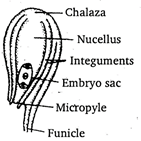Life Cycle Of Angiosperms MCQ Test - 1, State PMT - NEET MCQ
30 Questions MCQ Test - Life Cycle Of Angiosperms MCQ Test - 1, State PMT
Orthotropus ovule belongs to :-
[Uttaranchal PMT 2004]
In a flowering plant, megaspore develops into an embryo sac, which contains :
-[Uttaranchal PMT 2004]
| 1 Crore+ students have signed up on EduRev. Have you? Download the App |
The adaptation of pollination found in Calotropis is :-
[Uttaranchal PMT 2004]
Apogamy is :-
[Uttaranchal PMT 2004]
When vegetative cells of sporophyte form an embryo it is called :-
[Uttaranchal PMT 2005]
When seed germinates, while the fruit is attached to parent plant, it is called :-
[Uttaranchal PMT 2005, C.G.06]
Pollinia are present in family :-
[Uttaranchal PMT 2005]
Nuclear endosperm is present in :-
[Uttaranchal PMT 2005]
Development of embryo from a cell of embryo sac other than egg is an example of :-
[Uttaranchal PMT 2006]
Seed coat is derived from :-
[Jharkhand 2003]
What is pollen grain :-
[Jharkhand 2003]
Entry of pollen tube through micropyle is :-
[Jharkhand 2004]
Micropyle helps in :-
[Jharkhand 2004]
Ovule with hilum lying close to micropyle is known as :-
[Jharkhand 2005]
Syngamy is the process in which :-
[Jharkhand 2005]
In embryo sac, n 2n, 3n conditions are found respectively in :-
[Jharkhand 2006]
In angiosperms, endosperm is formed by :-
[UP CPMT 2001]
Endosperm of angiospermic plant is :-
[UP CPMT 2002]
Rarely among angiosperms the pollen grains influences the endosperm. This is called as :-
[UP CPMT 2004]
Pollination in which pollen grains of one flower are transferred to the stigma of another flower of the same plant is called :-
[UP CPMT 2005]
Aleurone layer is part of :-
[UP CPMT 2005]
Function of embryonal suspensor in angiosperms is to :-
[UP CPMT 2005]
Microsporophyll contains :-
[UP CPMT 2006]
Nucellus forms which of the following part of fruit:-
[UP CPMT 2007]
If root of a flowering pant has 24 chromosomes, then its gamete has how many chrimosomes :-
[UP CPMT 2007]
Caruncle is formed by :-
[CG CPMT 2004]


















